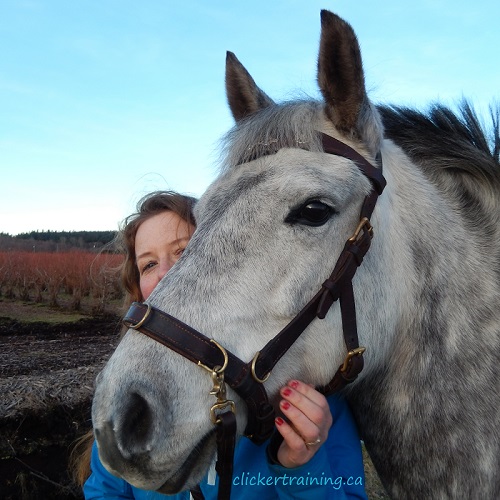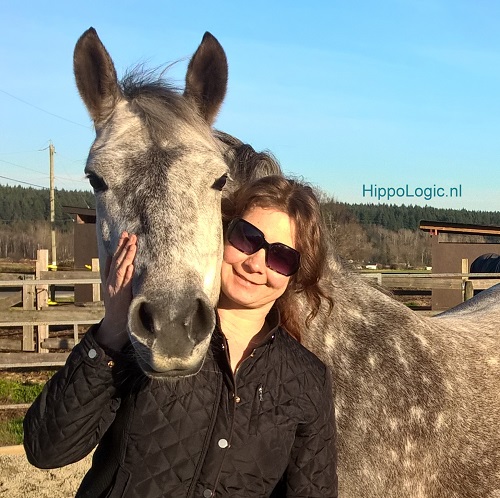When your vet just told you: “No more treats for your horse! She needs to lose weight immediately!”. You might worry how to clicker train your horse, now treats are forbidden by a professional you trust! 5 Tips to keep clicker training your overweight horse.

Feeding Treats vs Using Food Appetitives
I find that there is a difference when someone with a traditional background tells you “No more treats”. In the ‘general horse world’ treats mean: commercial horse treats made with lots of molasses, apples (high in sugar), carrots (also high in sugar), maybe even sugar cubes (when I was a kid I was told that horses love them!).
Horses need to eat! Even fat horses need forage. That’s tip #1.
Tip #1 Use Food Reinforcers From Your Horse’s Diet
The reason equine vets are against feeding obese horses treats is obviously for health reasons! Remember: they are the ones that see all the bad things that are a result of overfeeding horses, or feeding the wrong diets! We usually don’t call our vet to check on our healthy horses, unless when we buy a horse. So vets have plenty of good reasons for this advise!

Instead of adding treats or food reinforcers to your horse’s diet, subtract them from his diet, so that you can use them to train!
Does your horse get hay cubes or soaked beetpulp? Those can be great appetitives in training. You already know that your horse loves these! Even vitamin/mineral pellets (in small quantities!) can be used in training.
Tip #2: Measure the Amount of Appetitives
Before you start clicker training your horse, take out the total amount of food your horse is able to have that day. Put that amount aside for training. Don’t add anything else!
I have two mini horses now and they are getting chubby. So I really am strict to set aside two little hands of normal grass pellets (no molasses) for their training. It looks so little! It’s difficult!
I made up a rule for myself to help me: once my treat bag is empty I can’t have any refills! When I had Kyra, who was 14.2 hands tall, I could use way bigger amounts. I realize that this is just something in my head. I will get used to it
Tip #3 Feed Smaller Portions (Without Frustration)
I don’t recommend being really frugal with treats in training, but using a high rate of reinforcement (RoR) can help train faster. I prefer 3 or 4 pellets for each click, use a high RoR and also give general amounts for really good outcomes. Keep in mind that I train mini horses! But this might work for your horse, too
I rather train a bit shorter (because the daily ration is used up) than train longer and get worried about feeding more calories in training than they use up.
Feeding less food in training will help you become more clear about your goal! If you’re worried that the calorie intake during your sessions are bigger than than that your horse burns off: choose movement behaviours.
Tip #4 Focus on Movement in Training!
Ask your horse to burn some calories with clicker training! This will make Force Free Movement Training FUN for your horse. Even though exercising is aversive for most overweight horses, they are also often highly motivated by food! There is a reason they are obese.

Tip #5 Use Non Food Reinforcers
Did you know you can reinforce behaviour with … behaviour!
When you have a limited amount of food for training, find those things your horse loves to do, to reinforce the behaviour! Most overweight horses like to do ‘nothing’. I’ve successfully used Key Lesson Mat Training as reinforcer for high energy behaviours in the beginning of our Force Free Movement Training.
You can also make a ‘behaviour chain’ (I like to back chain behaviours for quick results) so that you get more behaviour for one appetitive.
Train without Frustration!
Make sure your horse doesn’t get frustrated in training, or you might have to fall back on a high RoR or even feeding more, instead of less. It can happen to the best of us. Point is that we learn (quickly) from our mistakes and avoid them in the future!
Force Free Movement Training for Horses
Is your horse overweight? Are you facing laminitis? Did the vet recommended: No more treats!” or “You have to exercise more” to get your horse in shape? Do you struggle getting your horse in shape with non ridden exercises, trained without coercion?
Consider my program R+ Movement Training for Horses. We’ll address your biggest struggle in getting your horse to move with positive reinforcement. You can apply to this one year program with this application form or by having a conversation with me. I tailor this online coaching program towards your horse, your situation and your needs!
To see if you’re a fit I offer a free assessment. In the assessment we’ll find out what’s holding you back and you’ll find out what you can change to get your horse in shape. There is no obligation to join my program afterwards. People have told me the assessment is a great tool and gave them lots of insights. Book a free assessment
- Building duration in exercising your horse with R+
- Getting your horse in shape and lose weight without a crash diet
- Teach your horse to move by himself, at liberty and other non ridden exercises
Sandra Poppema, BSc
Founder of the HippoLogic and creator of Force Free Movement Training for Laminitis Horses

New to Clicker Training?
Get my Confident Clicker Trainer course, an high quality, extended online program that teaches you to clicker train your horse.
No matter when you’re new or already advanced (clicker training 2-6 years) this course will offer you many new angles and approaches to enhance and deepen your skills.
You’ll get:
- My proven R+ training step-by-step system that gives you predictable results (It tells you when and how to introduce a cue, when and how to strengthen a behaviour, raise your criteria and get behaviour under stimulus control and so on)
- Includes 6 Keys to Success for Trainers from creating Accountability to Shaping plans
- 8 Modules to teach your horse 6 basic behaviours, the Key Lessons for Horses, that will help you train all future behaviours faster
- Tons of instruction and step-by-step training videos






You must be logged in to post a comment.